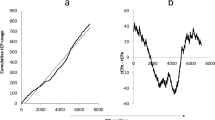Summary
The genomic relatedness among representative rotavirus strains was examined by employing cross-hybridization techniques. Single stranded (ss) RNA prepared byin vitro transcription of purified rotavirus particles and labeled with either32P or125I was hybridized to denatured genomic, double stranded (ds) RNAs. The hybrids formed were analyzed by polyacrylamide gel electrophoresis (PAGE) or by testing their sensitivity to digestion with single strand specific nuclease (S-1 nuclease). A relatively high degree of genomic homology was found to exist among several bovine rotavirus strains obtained from different geographical areas. Similarly, a high degree of homology was found between two different simian rotavirus strains, and also between two porcine strains. The human Wa strain exhibited a low degree of genomic homology with simian, bovine and canine strains whereas a higher level of homology was detected between the human Wa strain and the porcine strains. The observed RNA sequence divergences of rotaviruses isolated from different animal species are in agreement with the restricted host range of these viruses and their known antigenic differences and suggest a divergent evolution of their genomes.
Similar content being viewed by others
References
Bohl, E. H., Theil, K. W., Saif, L. J.: Isolation and serotyping of porcine rotaviruses and antigenic comparison with other rotaviruses. J. Clin. Microbiol.19, 105–111 (1984).
Both, G. W., Siegman, L. J., Bellamy, A. R., Ikegami, N., Shatkin, A. J., Furuichi, Y.: Comparative sequence analysis of rotavirus genomic segment 6—the gene specifying viral subgroups 1 and 2. J. Virol.51, 97–101 (1984).
Commerford, L.: Iodination of nucleic acidsin vitro. Biochemistry10, 1993–1999 (1971).
Flores, J., Myslinski, J., Kalica, A. R., Greenberg, H. B., Wyatt, R. G., Kapikian, A. Z., Chanock, R. M.:In vitro transcription of two human rotaviruses. J. Virol.43, 1032–1037 (1982).
Flores, J., Perez, I., White, L., Perez, M., Kalica, A. R., Marquina, R., Wyatt, R. G., Kapikian, A. Z., Chanock, R. M.: Genetic relatedness among human rotaviruses as determined by RNA hybridization. Infect. Immun.37, 648–655 (1982).
Glass, R. I., Keith, J., Nakagomi, O., Nakagomi, T., Askaa, J., Kapikian, A. Z., Chanock, R. M., Flores, J.: Nucleotide sequence of the structural glycoprotein VP7 gene of NCDV rotavirus: comparison with homologous genes from 4 strains of human and animal rotaviruses. Virology141, 292–298 (1985).
Greenberg, H. B., Kalica, A. R., Wyatt, R. G., Jones, R. W., Kapikian, A. Z., Chanock, R. M.: Rescue of noncultivatable human rotavirus by gene reassortment during mixed infection with ts mutants of a cultivatable bovine rotavirus. Proc. Nat. Acad. Sci. U.S.A.78, 420–424 (1981).
Hoshino, Y., Wyatt, R. G., Greenberg, H. B., Flores, J., Kapikian, A. Z.: Serotypic similarity and diversity of rotaviruses of mammalian and avian origin as studied by plaque-reduction neutralization. J. Infect. Dis.14, 694–702 (1984).
Hoshino, Y., Wyatt, R. G., Scott, F. W., Appel, M. J.: Isolation and characterization of a canine rotavirus. Arch. Virol.72, 113–125 (1982).
Kalica, A. R., Flores, J., Greenberg, H. B.: Identification of the rotaviral gene that codes for hemagglutination and protease-enhanced plaque formation. Virology125, 194–205 (1983).
Kapikian, A. Z., Chanock, R. M.: Rotavirus. In:Fields, B. N. (ed.), Virology. New York: Raven Press (1985).
Kapikian, A. Z., Cline, W. L., Greenberg, H. B., Wyatt, R. G., Kalica, A. R., Banks, C. E., James, H. D., Jr., Flores, J., Chanock, R. M.: Antigenic characterization of human and animal rotaviruses by immune adherence hemagglutination assay (IAHA): evidence for distinctness of IAHA and neutralization antigens. Infect. Immun.33, 415–425 (1981).
Laemmli, U. K.: Cleavage of structural proteins during the assembly of the head of bacteriophage T. Nature (London)227, 680–685 (1970).
Malherbe, H. H.: Simian virus SA-11 and the related 0 agent. Arch. Virusforsch.22, 235–239 (1967).
Mebus, C. A., Underdahl, N. R., Rhodes, M. B., Twiehaus, M. J.: Calf diarrhea (scours): reproduced with a virus from a field outbreak. The Agric. Exp. Station Res. Bull. No. 233, 1969. Lincoln, Nebraska College of Agriculture. University of Nebraska.
Mebus, C. A., Wyatt, R. G., Sharpee, R. L., Sereno, M. M., Kalica, A. R., Kapikian, A. Z., Twiehaus, M. J.: Diarrhea in gnotobiotic calves caused by the reovirus-like agent of human infantile gastroenteritis. Infect. Immun.14, 471–474 (1976).
Okada, Y., Richardson, M. A., Ikegami, N., Furuichi, Y.: Nucleotide sequence of human rotavirus genome segment 10, an RNA encoding a glycosylated virus protein. J. Virol.51, 856–859 (1984).
Rodger, S. M., Bishop, R. F., Birch, C., McLean, B., Holmes, I. H.: Molecular epidemiology of human rotaviruses in Melbourne, Australia, from 1973 to 1979 as determined by electrophoresis of genome ribonucleic acid. J. Clin. Microbiol.13, 272–278 (1981).
Schroeder, B. A., Street, J. E., Kalmakoff, J., Bellamy, A. R.: Sequence relationships between the genome segments of human and animal rotavirus strains. J. Virol.43, 379–385 (1982).
Stuker, G., Oshiro, L. S., Schmidt, N. J.: Antigenic comparisons of two new rotaviruses from Rhesus monkeys. J. Clin. Microbiol.11, 202–203 (1980).
Woode, G. N., Bridger, J. C., Hall, C., Dennis, M. J.: The isolation of a reovirus-like agent associated with diarrhea in colostrum-deprived calves in Great Britain. Res. Vet. Sci.16, 102–111 (1974).
Wyatt, R. G., James, W. D., Bohl, E. H., Theil, K. W., Saif, L. J., Kalica, A. R., Kapikian, A. Z., Chanock, R. M.: Human rotavirus type 2: cultivationin vitro. Science207, 189–191 (1980).
Author information
Authors and Affiliations
Additional information
With 5 Figures
Rights and permissions
About this article
Cite this article
Flores, J., Hoshino, Y., Boeggeman, E. et al. Genetic relatedness among animal rotaviruses. Archives of Virology 87, 273–285 (1986). https://doi.org/10.1007/BF01315305
Received:
Accepted:
Issue Date:
DOI: https://doi.org/10.1007/BF01315305




